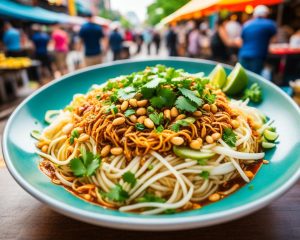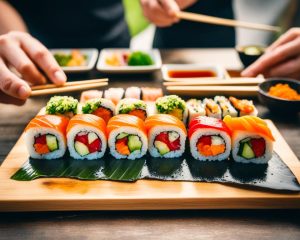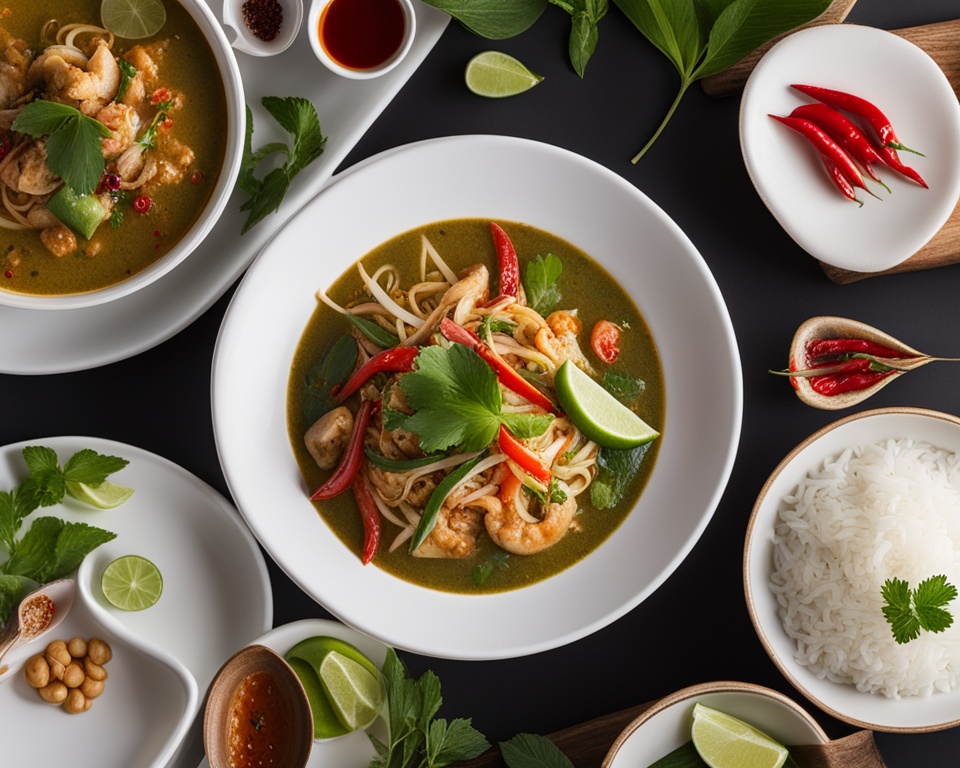
Thailand is renowned for its vibrant and flavorful asian food thailand cuisine, which offers a delightful fusion of Asian culinary influences. From the bustling streets of Bangkok to the idyllic coastal regions, thai cuisine showcases a harmonious blend of sweet, sour, salty, and spicy flavors that captivate the senses. This article will take you on a culinary journey through the diverse landscape of authentic Thai cuisine, exploring the iconic dishes, regional variations, and the rich cultural heritage that shapes this remarkable gastronomic experience.
Read more interesting information at ::102aoki
Exploring the Vibrant Culinary Landscape of Thailand
Thailand’s asian food thailand landscape is a tapestry of diverse influences, blending the flavors of its neighboring countries with its own unique culinary traditions. From the Chinese and Indian spices that have been integrated into thai cuisine to the seafood-centric dishes of the coastal regions, the country’s cuisine is a testament to its rich cultural heritage.
Thailand’s Diverse Culinary Influences
The thailand travel culinary landscape of Thailand has been shaped by a variety of cultural influences over the centuries. The introduction of Chinese and Indian spices, herbs, and cooking techniques has had a significant impact on the evolution of Thai cuisine, creating a harmonious fusion of flavors. Similarly, the abundance of fresh seafood in the coastal regions has led to the development of distinctive seafood-based dishes that showcase the country’s proximity to the ocean.
Regional Thai Cuisine Variations
Each region of thailand boasts its own distinct culinary specialties, reflecting the local ingredients and cooking techniques that have been passed down through generations. From the robust curries of the north to the fragrant, herb-infused dishes of the northeast, the diversity of thai cuisine is a true celebration of the country’s cultural heritage.
Bangkok: A Street Food Paradise
Bangkok, the vibrant capital of Thailand, is renowned as a mecca for bangkok street food enthusiasts. The city’s bustling streets and alleyways are filled with an array of tantalizing food stalls, each offering a wide variety of traditional Thai dishes and snacks. From the sizzling woks of the Pad Thai vendors to the fragrant aromas of the Tom Yum Goong soup sellers, Bangkok’s street food scene is a sensory delight that showcases the country’s culinary prowess.
Navigating the maze of Bangkok’s thailand travel street food landscape is an immersive and enriching experience. Vendors selling a diverse array of local specialties, from the ubiquitous Som Tam (green papaya salad) to the fragrant Massaman Curry, line the city’s thoroughfares, creating a vibrant and dynamic culinary atmosphere. The sights, sounds, and smells of these bustling food stalls captivate the senses, inviting visitors to indulge in the authentic flavors that have made Thai street food a global phenomenon.
Exploring Bangkok’s street food scene not only satisfies the palate but also offers a glimpse into the city’s rich cultural heritage. Each dish showcases the intricate balance of sweet, sour, salty, and spicy flavors that are the hallmark of Thai cuisine, reflecting the culinary traditions that have been passed down through generations. Whether it’s the crispy, golden Moo Ping (grilled pork skewers) or the creamy, coconut-infused Khao Niaow Ma Muang (mango sticky rice), every bite is a testament to the skill and creativity of the city’s street food vendors.
For those seeking an authentic thailand travel experience, immersing oneself in the vibrant street food culture of Bangkok is a must. From the bustling Yaowarat Road in Chinatown to the lively Khao San Road, the city’s street food scene offers a captivating journey through the diverse flavors and vibrant energy that make Thailand’s culinary landscape so remarkable.
Iconic Thai Dishes to Savor
Thai cuisine boasts a rich repertoire of iconic dishes that have become beloved favorites around the world. From the stir-fried rice noodles of Pad Thai to the fragrant and spicy Tom Yum Goong soup, these quintessential Thai delicacies showcase the country’s culinary mastery and the harmonious balance of flavors that define its gastronomic heritage.
Pad Thai: The National Noodle Dish
Pad Thai, the national noodle dish of Thailand, is a captivating blend of flavors and textures. This stir-fried rice noodle dish combines shrimp, eggs, bean sprouts, and a sweet-savory sauce that tantalizes the taste buds. The perfect balance of salty, sweet, and sour notes, coupled with the crunch of peanuts, makes Pad Thai a beloved staple of Thai cooking and a must-try for visitors exploring the thailand travel culinary landscape.
Tom Yum Goong: A Tantalizing Shrimp Soup
Another quintessential Thai delicacy is Tom Yum Goong, a tangy and spicy shrimp soup that showcases the harmonious blend of lemongrass, kaffir lime leaves, galangal, and fresh seafood. This aromatic soup is a showcase of the country’s exceptional thai cooking techniques, with each ingredient contributing to the depth and complexity of the flavors. The combination of sour, spicy, and savory notes creates a truly captivating culinary experience.
Massaman Curry: A Rich and Flavorful Delight
Massaman curry, a distinctive Thai dish with Persian and Indian influences, is a standout among the country’s many curries. This rich and aromatic dish features tender chunks of meat, potatoes, and peanuts simmered in a complex blend of spices, including cinnamon, cardamom, and star anise. The origins of Massaman curry can be traced back to the culinary exchange between Thailand and the Middle East, resulting in a unique flavor profile that sets it apart from other Thai curries.
Origins and Ingredients of Massaman Curry
The origins of Massaman curry can be traced back to the cultural and culinary exchange between Thailand and the Middle East. This unique Thai dish showcases the influence of Persian and Indian spices and cooking techniques, blending them seamlessly with the quintessential Thai flavors. The key ingredients in Massaman curry include tender meat, potatoes, peanuts, and a complex spice mixture featuring cinnamon, cardamom, star anise, coriander, cumin, and nutmeg. This harmonious combination of flavors creates a truly distinctive and indulgent Thai culinary experience.
Som Tam: Thailand’s Iconic Green Papaya Salad
Som Tam, the iconic green papaya salad, is a quintessential Thai dish that showcases the country’s love for bold, zesty flavors. This refreshing salad features shredded unripe papaya tossed with a tangy and spicy dressing made with fish sauce, lime juice, chilies, and a variety of crunchy vegetables and herbs. Som Tam is a beloved staple in Thai cuisine, enjoyed as a side dish or a light main course.
The key to an authentic som tam lies in the perfect balance of flavors and textures. The shredded papaya provides a crisp, refreshing base, while the fish sauce, lime juice, and chilies create a tangy and spicy dressing that tantalizes the taste buds. The addition of crunchy vegetables, such as tomatoes, long beans, and carrots, as well as fragrant herbs like cilantro and mint, adds depth and complexity to this beloved Thai dish.
Whether enjoyed as a refreshing appetizer or a light main course, som tam has become a beloved icon of Thai cuisine. Its combination of vibrant flavors and textures makes it a must-try for any Thailand traveler seeking to immerse themselves in the country’s rich culinary traditions.
Mango Sticky Rice: A Sweet and Creamy Treat
Mango sticky rice, a beloved Thai dessert, is a sweet and creamy indulgence that perfectly encapsulates the country’s culinary artistry. This dish features sticky rice cooked in rich coconut milk, topped with ripe, juicy mangoes and a drizzle of sweetened coconut sauce. The contrast of the warm, soft rice and the cool, refreshing mango creates a harmonious balance of flavors and textures that have made mango sticky rice a must-try for visitors to Thailand.
| Ingredient | Quantity |
|---|---|
| Sticky Rice | 2 cups |
| Coconut Milk | 1 (13.5 oz) can |
| Palm Sugar | 1/4 cup |
| Salt | 1/4 teaspoon |
| Ripe Mangoes | 2 large |
The key to the perfect mango sticky rice lies in the careful preparation of the sticky rice. The rice is first soaked in water, then steamed until tender and fluffy. It is then mixed with the rich, creamy coconut milk, palm sugar, and a pinch of salt, creating a luscious base for the dish. The final touch is the addition of fresh, ripe mangoes, their sweet and juicy flesh complementing the warm, comforting rice perfectly.
Mango sticky rice is a true representation of the harmonious balance of flavors that defines Thai cuisine. Its popularity has made it a must-try for travelers exploring the culinary delights of Thailand, leaving a lasting impression on all who indulge in this sweet and creamy treat.
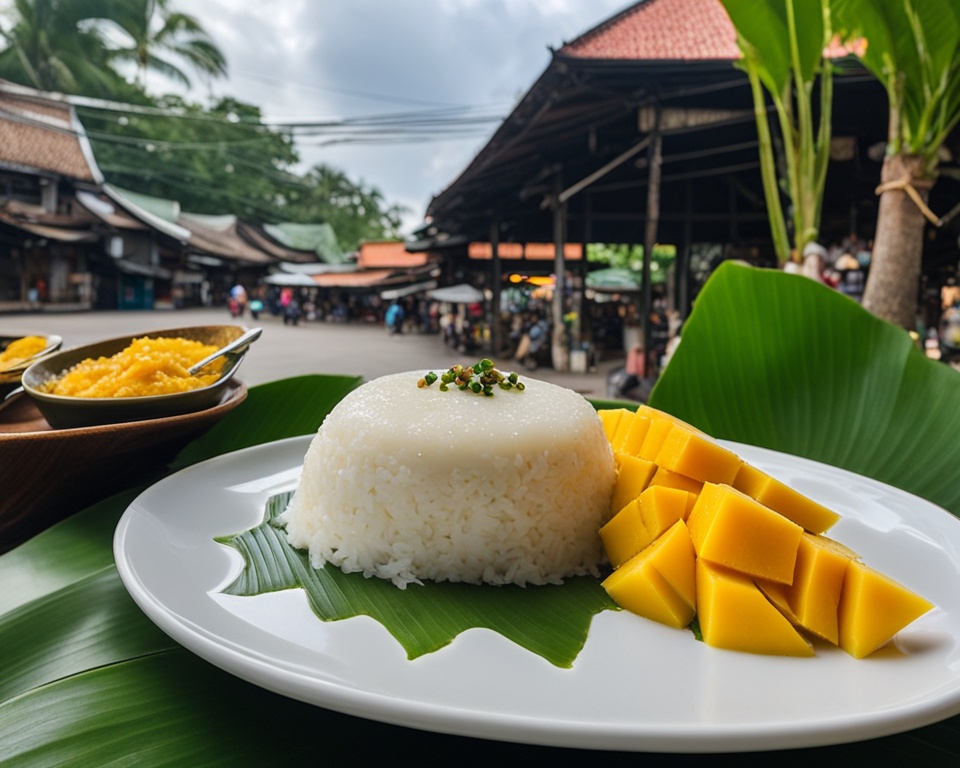
Asian Food Thailand: Authentic Thai Flavors
The essence of authentic thai cuisine lies in the skillful blending of traditional cooking techniques and the use of quintessential thai ingredients and spices. From the intricacies of stir-frying to the slow simmering of curries, thai chefs have perfected the art of creating vibrant, balanced flavors.
Traditional Thai Cooking Techniques
Key thai cooking techniques include the delicate balance of sweet, sour, salty, and spicy flavors, as well as the precision of stir-frying and the slow, gentle simmering of curries. These methods, honed over generations, allow thai cuisine to showcase the natural umami and complexity of its ingredients.
Essential Thai Ingredients and Spices
Ingredients such as fish sauce, palm sugar, lemongrass, galangal, and kaffir lime leaves are essential to the unique taste profile of thai dishes, while spices like chilies, cumin, and coriander add depth and complexity to the overall culinary experience. These asian food thailand staples come together to create the signature flavors that have made thai cuisine so beloved worldwide.
Thai Cuisine: A Harmonious Balance of Flavors
At the heart of Thai cuisine lies a harmonious balance of sweet, sour, salty, and spicy flavors. This delicate interplay of tastes is achieved through the careful selection and combination of ingredients, as well as the skillful execution of cooking techniques.
Sweet, Sour, Salty, and Spicy
The sweet notes often come from palm sugar or coconut milk, while the sour elements are contributed by ingredients like lime juice, tamarind, and vinegar. The salty dimension is typically provided by fish sauce or soy sauce, and the spicy kick is introduced through the use of chilies and other pungent spices. This intricate balance of flavors is what makes Thai cuisine so captivating and memorable.
Vegetarian and Vegan Thai Dishes
Thai cuisine offers a diverse array of vegetarian and vegan-friendly options that showcase the country’s culinary versatility. From the ubiquitous Pad Thai made with tofu to the aromatic Thai curries simmered in coconut milk, there are plenty of plant-based delights to satisfy every palate. The abundance of fresh vegetables, herbs, and flavorful sauces in Thai cooking make it easy to create delicious and nourishing vegetarian and vegan dishes that seamlessly blend with the country’s culinary traditions.
Plant-Based Thai Cooking
Exploring the world of thailand travel and its vibrant thai cooking reveals an array of vegetable-based dishes that showcase the ingenuity of Thai chefs. Traditional curries, such as the iconic Red Curry and Green Curry, can be effortlessly transformed into plant-based masterpieces by substituting meat with a variety of fresh produce, including eggplant, bamboo shoots, and tofu. Likewise, stir-fried dishes like Pad Krapao (Holy Basil Stir-Fry) and Pad Pak Boong (Morning Glory Stir-Fry) offer a bounty of vegetarian and vegan options that showcase the vibrant, bold flavors of Thai cuisine.
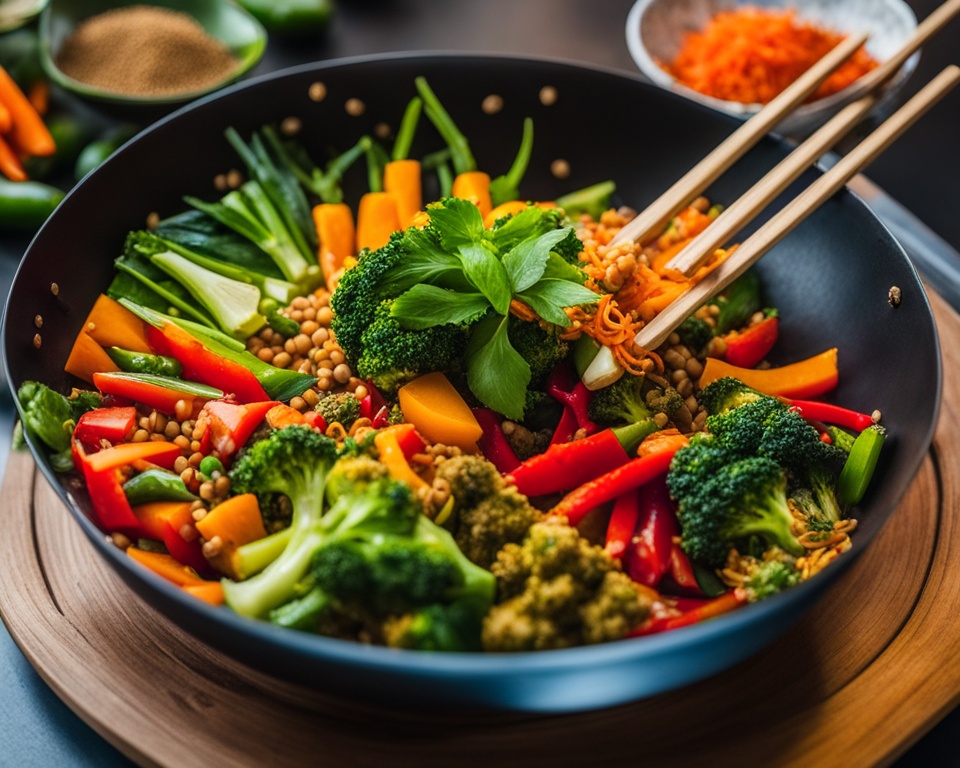
The versatility of thai cooking also extends to the realm of noodle dishes, with Pad Thai and Khao Soi (Northern Thai Curry Noodles) easily adaptable to plant-based diets. By embracing the abundance of fresh, locally sourced ingredients and the skillful blending of aromatic herbs and spices, Thai chefs have crafted a vibrant vegetarian and vegan culinary landscape that celebrates the country’s rich gastronomic heritage.
Thai Cooking Classes: Immerse Yourself in the Flavors
For those eager to delve deeper into the art of Thai cuisine, attending a cooking class is a wonderful way to immerse yourself in the flavors and techniques of this captivating culinary tradition. Whether in the bustling streets of Bangkok or the serene countryside, these interactive experiences offer an opportunity to learn from skilled local chefs, uncover the secrets of authentic thai cooking, and gain hands-on experience in preparing iconic dishes. By engaging in these culinary workshops, visitors can not only savor the flavors of thailand travel but also develop a deeper appreciation for the culture and traditions that shape this remarkable gastronomic heritage.
Dining Etiquette in Thailand
When dining in thailand travel, it is important to be mindful of the local customs and etiquette to fully appreciate the cultural experience. Thai meals are often shared among family and friends, with dishes placed in the center of the table for everyone to enjoy. It is considered polite to eat with a spoon and fork, using the fork to push food onto the spoon. Chopsticks are typically reserved for noodle dishes. Additionally, it is customary to leave a small portion of food on the plate as a sign of respect and to avoid appearing overly hungry.
Cultural Tips for Enjoying Thai Meals
As you immerse yourself in the thailand travel culinary landscape, understanding and adhering to the dining etiquette can enhance your overall experience. By embracing the shared, communal nature of Thai meals and respecting the local customs, you can fully savor the flavors and connect with the rich cultural heritage that shapes this remarkable gastronomic tradition.
Thailand Travel: Culinary Adventures Await
Exploring the culinary landscape of Thailand offers endless opportunities for thailand travel and thai cooking enthusiasts. From guided food tours that take visitors through the bustling street food stalls and local markets to immersive experiences at traditional Thai festivals and food celebrations, there are countless ways to delve into the country’s rich gastronomic heritage.
Food Tours and Local Markets
For an authentic taste of Thailand, food tours provide an excellent way to navigate the vibrant street food scene and discover hidden gem eateries. These guided experiences often take travelers through the bustling markets, where they can witness the preparation of iconic Thai dishes and interact with the skilled local chefs and vendors. Wandering through the colorful stalls brimming with fresh produce, fragrant spices, and tantalizing aromas is a sensory delight that truly captures the essence of thailand travel.
Thai Festivals and Food Celebrations
Thailand’s rich cultural heritage is celebrated through a variety of festivals and food-centric events that offer visitors a unique opportunity to immerse themselves in the country’s culinary traditions. From the renowned Songkran water festival to the annual Vegetarian Festival, these celebrations showcase the diverse regional cuisines, traditional cooking techniques, and the deep-rooted connection between Thai food and the local way of life. Participating in these festivities not only allows visitors to savor the authentic flavors of thai cooking but also provides insights into the customs and rituals that shape the nation’s vibrant gastronomic identity.
Recreating Thai Flavors at Home
For those who can’t venture to Thailand but still crave the bold, tantalizing flavors of Thai cuisine, there are numerous resources available to help recreate these dishes at home. Whether you’re a seasoned home cook or a beginner in the kitchen, the right tools and guidance can bring the vibrant tastes of Thailand into your own kitchen.
Essential Thai Cookbooks
Essential Thai cookbooks, written by renowned chefs and culinary experts, offer detailed recipes and techniques for preparing authentic Thai meals. From the classic “Thai Food” by David Thompson to the innovative “Simple Thai Food” by Leela Punyaratabandhu, these books delve into the intricacies of Thai cooking, providing step-by-step instructions and insights into the cultural traditions that shape the country’s cuisine. With these resources, home cooks can master the art of creating dishes like the iconic Pad Thai, the rich and aromatic Massaman curry, and the refreshing Som Tam salad.
Online Thai Cooking Resources
In addition to traditional cookbooks, a wealth of online resources, from cooking blogs to instructional videos, provide step-by-step guidance on mastering the art of Thai cooking. These digital platforms offer a wealth of information, from recipe tutorials to culinary techniques, allowing home cooks to explore the diverse flavors and methods of Thai cuisine at their own pace. Whether you’re looking to perfect your Pad Thai or experiment with lesser-known regional dishes, these online resources can be invaluable in your quest to bring the vibrant tastes of Thailand into your home kitchen.
With the right tools and a little bit of culinary exploration, home cooks can embrace the bold and harmonious flavors of Thai cooking and create authentic Thai dishes that transport them to the bustling streets of Bangkok or the serene beaches of the southern islands.
